Your example is still quite far from reproducible. We aren't trying to be difficult when we ask for reproducibility. Please keep in mind that you are asking random strangers to take time out of their day (on a weekend!) to help you. It's only polite for you to do as much of the work up front as possible. If I can simply copy+paste some code and run it in a clean R session to see what's happening, I'm much more likely to devote time to the question. Here's what I mean:
Create some reproducible data:
dat <- data.frame(x = 1:10,y = sample(10,10,replace = TRUE))
That was one line, and makes life for the answerer so much easier. The other reason we ask that people provide reproducible examples is that doing so often causes you to solve your own problem.
As I went through the process of developing this reproducible example, I first made this plot:
ggplot(dat,aes(x = x,y = y)) +
geom_point() +
scale_y_continuous(breaks = seq(1,10,0.5))

Everything looks fine, right? But note that since the default panel background is grey, the grid lines are white. Alarm bells should be going off in your head at this point...
Next I plotted this:
ggplot(dat,aes(x = x,y = y)) +
geom_point() +
scale_y_continuous(breaks = seq(1,10,0.5)) +
opts(panel.background = theme_rect(fill='white', colour='gray'))

Note that the "grid lines" now are not actually the grid lines. They are the borders of of your theme_rect background. That's what happens when you specify a color for a 2D object; the borders are colored.
At this point I realized that the we just need to recolor the grid lines:
ggplot(dat,aes(x = x,y = y)) +
geom_point() +
scale_y_continuous(breaks = seq(1,10,0.5)) +
opts(panel.background = theme_rect(fill='white', colour='gray'),
panel.grid.minor = theme_blank(),
panel.grid.major = theme_line(colour = "grey80"))

I've removed the minor grid lines with theme_blank and simply recolored the major ones. They were there all the time, just drawn in white!
So the lesson here is that making a reproducible example isn't just us answerers being lazy...it benefits you too! :)



